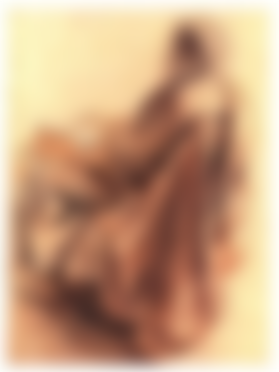What colour pigment was originally made from a substance secreted by cuttlefish? Now made synthetically, the colour is still called the same.
The answer is sepia. It is a secretion of the common cuttlefish, Sepia officinalis, a pigment containing melanin. (Melanin is the same pigment that colours human skin and hair.)
A German painter and professor, Jacob Seydelmann (1750-1829), developed a method to get sepia more concentrated, which was essential for its use in art. Before that it was used mainly for writing. It is, however, a very sensitive pigment that will rapidly break down by exposure to light and oxygen. In a painting it will fade in just a few years.
For the artist, an impression of sepia can be reached by mixing carbon black and red oxide, or (with a slightly different tone) by mixing ultramarine and raw umber with carbon black. With these pigments, the colour will last longer.
In medicine, sepia is found mainly within homeopathy, where it is one of the polychrests. That is, substances with a very wide range of effects on the whole organism, one that can be used for many ailments. It is especially useful in the treatment of typically female problems related to the reproductive organs. But its use is not limited to that.
Although known from Roman Antiquities, then used for writing, sepia did not have its great breakthrough in art until the Renaissance, and it is still used for the special atmosphere it conveys. Occasionally a photo or a film is artificially toned in sepia in order to create an impression of dreamlike timelessness.
The image below shows a drawing in sepia by one of the greatest in European art history, Rembrandt van Rijn (1606-1669). The picture shows a man who is reading.

Grisaille, a word stemming from French “gris”, grey, became popular from the 14th century. Strictly a painting made “en grisaille”, is made only with different shades of grey, but more freely used, it came to include colours sepia and dark green. However, strictly, painting in shades of dark green is called “verdaille”.
This is a painting made purely “en verdaille”: “A chinoiserie procession of figures riding on elephants with temples” by Jean-Baptiste Pillement (1728-1808).

Monochrome art (monochrome means that it is made in different shades of only one colour) – or even art made in shades of only two or three colours - can be very expressive.
We can see other examples in Japanese art. I have previously written about Aka-e (red pictures) in Aka-e – Japanese Colour Magic, and Aizuri-e (blue pictures) in Prussian Blue & Aizuri-e - Blue Pictures. But they had several special genres based on the limits in use of colour. Let's look at the Japanese art of woodblock prints in the style commonly called ukiyo-e.
The first Japanese woodcut prints were black and white. Colour, where it occurred, was added manually afterwards. In the beginning of the 17th century, one used mainly orange, and sometimes green or yellow. Those prints were called tan-e.
In the 1720s, pink came into fashion, and the pinkish style that followed was called beni-e. Subsequently followed a style called urushi-e; a mixture of ink and animal glue resulted in a blank, lacquer-like surface.
Benizuri-e, which peaked in the 1740s, were printed directly with colours, pink and green. Sometimes some other colour was added by hand. (Example here.)
In the 1760s, at last, came the nishiki-e, the full colour print. The technique was developed by the great master Haronubu. He sometimes used a dozen woodblocks for a single print, one woodblock for each colour.
Beni-girai-e literally translates to “picture hating red”. It was a style practised mainly in 1780s, where the artist avoids all use of red or reddish tones. It gives a very special colour effect.
The style is often associated with Katsukawa Shunchō (active about 1783-1795). However, in my opinion Kubo Shunman (about 1757-1820) is a greater benigirai-e master. Yet, one of the very best benigirai-e was created by Utamaro. The image below shows his print Three Lucky New Year Dreams: Fuji, Falcon, Eggplant – from about 1800.

Tags: @whitecatascend @Theblackdoll @ThisisGrace21
Related articles:
The Kreutzer Sonata: How Art Inspires to Art, which Inspires to Art...
Prussian Blue & Aizuri-e - Blue Pictures
Copyright © 2021 Meleonymica/Mictorrani. All Rights Reserved.
(The images of this article are all in the Public Domain.)
Here you can find my articles about History, and about Art, and here about Japanese art.
Interested in history, legends and myths, join my community History, Myths, Legends & Mysteries (be45); or in Japanese art, join Japanese Art & Cultural History.
You find all my writings on Read.Cash, sorted by topic, here.
My 5 most recent articles:
On the Genealogy of Script III - VIII
On the Genealogy of Script I & II



I can see sepia as vintage, usually if I search 'aesthetic design' this kind of color mostly is the result.